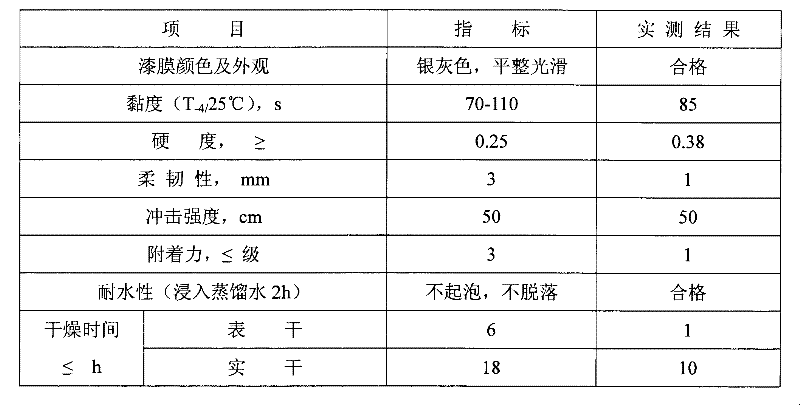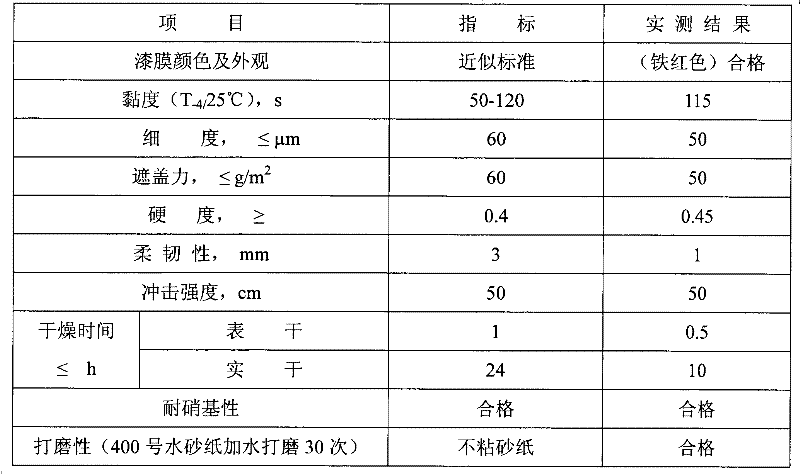Method for preparing phenolic resin from phenols residues and application thereof to production of coating
A phenolic resin and residue technology is applied in the application of phenolic resin in the production of coatings and the field of preparing phenolic resin, which can solve the problems of toxic and harmful substances discharge, increase in pollution treatment costs, and inability to achieve zero pollution discharge, and achieve good adhesion. , Solve the problem of phenol pollution, the effect of strong implementability
- Summary
- Abstract
- Description
- Claims
- Application Information
AI Technical Summary
Problems solved by technology
Method used
Image
Examples
Embodiment 1
[0037] Embodiment 1, the preparation of phenolic resin
[0038]Accurately weigh 100 parts of cresol residues, 200 parts of rosin, 20 parts of water, 0.5 parts of zinc oxide, and 1 part of ammonia water, add them to the reaction kettle, and raise the temperature. When the system reaches 80°C, add 60 parts of formaldehyde dropwise; , kept at this temperature for 5 hours to make it react fully; after detection of complete dissolution (detection of oil solubility and solubility, resin: linseed oil=1: 4, fully soluble; resin: toluene=1: 1, fully soluble), Add 20 parts of xylene, continue to heat up to 100°C, and dehydrate. After the removal, add 100 parts of soy oil, 60 parts of glycerin, 40 parts of phthalic anhydride, 3 parts of zinc oxide, and 0.1 part of silicone oil to the reaction kettle in sequence, and continue to raise the temperature. When the system reaches 220°C, keep it for 2 hours, and then start sampling , measure the viscosity and acid value, when the viscosity of ...
Embodiment 2
[0041] Embodiment 2, the preparation of phenolic resin
[0042] Accurately weigh 100 parts of phenol residue, 80 parts of rosin, 70 parts of petroleum resin, 50 parts of water, 1 part of zinc acetate, and 1 part of ammonia water, add them to the reaction kettle, raise the temperature, and add 40 parts of formaldehyde dropwise when the system reaches 100 °C; After dripping, keep it at this temperature for 5 hours to make it fully react; after the detection is completely dissolved (detect oil solubility and solubility, resin: linseed oil=1: 4, fully soluble; resin: toluene=1: 1, fully dissolve dissolved), add 30 parts of xylene, continue to heat up to 100°C, and dehydrate. After taking off, add 100 parts of linseed oil and 50 parts of pentaerythritol to the reaction kettle successively, raise the temperature to 240°C, keep it for 2 hours, and check the alcohol solubility. To 200°C, add 60 parts of phthalic anhydride, 3 parts of zinc acetate, and 0.1 part of silicone oil, and co...
Embodiment 3
[0045] Embodiment 3, the preparation of phenolic resin
[0046] Accurately weigh 100 parts of tert-butylphenol residue, 80 parts of rosin, 100 parts of coumarone resin, 50 parts of water, 1 part of copper sulfate, and 1 part of ammonia water, add them to the reaction kettle, and raise the temperature. When the system reaches 90 °C, drop Add 60 parts of formaldehyde; after dripping, keep at this temperature for 5 hours to make it fully react; after the test is qualified (detect oil solubility and solubility, resin: linseed oil=1: 4, fully soluble; resin: toluene=1 : 1, completely dissolved), add 40 parts of xylene, continue to heat up to 100°C, and dehydrate. After taking off, add 150 parts of soybean oil and 50 parts of pentaerythritol successively in the reaction kettle, heat up to 240° C., and after keeping for 2 hours, detect the alcohol solubility. At 200°C, add 50 parts of phthalic anhydride, 10 parts of benzoic acid, 5 parts of maleic anhydride, 3 parts of copper sulfat...
PUM
| Property | Measurement | Unit |
|---|---|---|
| acid value | aaaaa | aaaaa |
| water resistance | aaaaa | aaaaa |
| luster | aaaaa | aaaaa |
Abstract
Description
Claims
Application Information
 Login to View More
Login to View More - R&D
- Intellectual Property
- Life Sciences
- Materials
- Tech Scout
- Unparalleled Data Quality
- Higher Quality Content
- 60% Fewer Hallucinations
Browse by: Latest US Patents, China's latest patents, Technical Efficacy Thesaurus, Application Domain, Technology Topic, Popular Technical Reports.
© 2025 PatSnap. All rights reserved.Legal|Privacy policy|Modern Slavery Act Transparency Statement|Sitemap|About US| Contact US: help@patsnap.com



